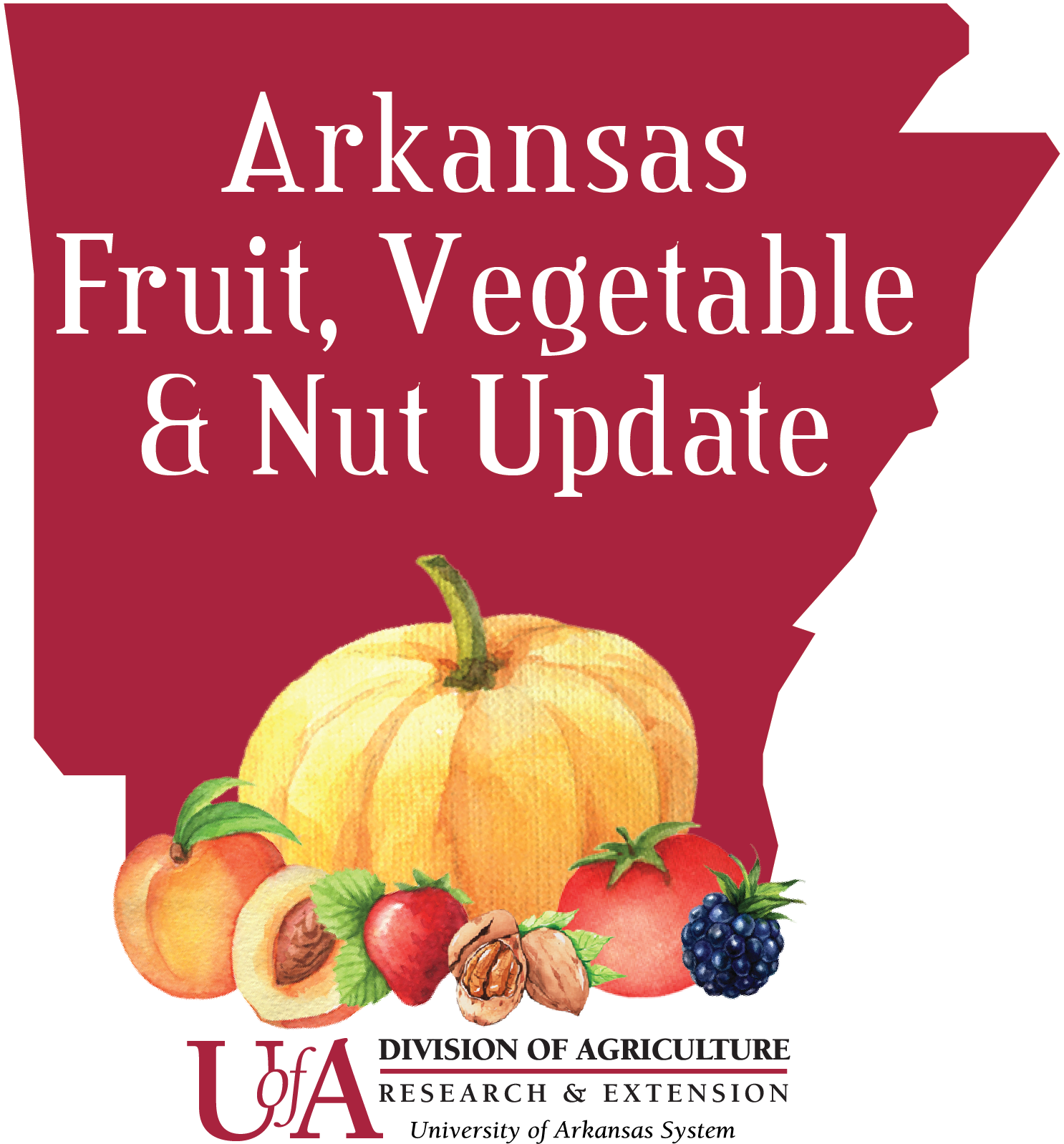
Fruit Crop Cold Damage and Outlook for Spring 2021 Following Freeze on February 16th
Artic air entered Arkansas during the week of February 14th, 2021. These abnormally cold temperatures have the potential to damage fruit crops and reduce their potential to produce fruit this coming spring and summer.
Amanda McWhirt, Horticulture Specialist
Ryan Neal, County Agent Benton County
Clyde Fenton, County Agent Sebastian County
Herb Ginn, County Agent Crawford County
Dave Freeze, County Agent Greene County
Sherrie Sanders, County Agent White County
Jesse Taylor, County Agent Franklin County
Austin Haines, Southwest REC
Artic air entered Arkansas during the week of February 14th, 2021. Low temperatures on Feb 16th reached 20-40° F below normal average temperatures for this time of year across the state.
|
Location |
Recorded Low Temperature* on Feb 16th 2021 |
|
Fayetteville |
-20 to -10 ° F |
|
Harrison |
-6 ° F |
|
Clarksville |
-6 to -15 ° F |
|
Little Rock |
-2° F |
|
Paragould |
-3 ° F |
|
Hope |
-7° F |
|
Pine Bluff |
0 ° F |
*Data from NOAA weather stations and local weather stations
These abnormally cold temperatures have the potential to damage fruit crops and reduce their potential to produce fruit this coming spring and summer.
There are a few things that are unique about this cold event:
- Most plants dormant
- Snow cover
- More than 4-6’’ of snow fell in many places before the coldest night on the 16th, and this provides many degrees of insulation to the base of plants or entire plants (strawberry).
- Extended cold period with many consecutive nights below 10-15° F
- Many parts of the state experienced 200+ continuous hours at temperatures below freezing. This increases the likelihood for damage to plants due to the extended period of very cold temperatures
- Low temperatures 10-15° F below the low temperatures that are typical for our area
- Some plants are not hardy to these extreme low temperatures
It is fortunate that most crops were still dormant, because at dormancy most plants have the most cold hardiness. However, the extreme low temperatures we experienced were much below the tolerance ranges for several fruit crops that are grown in Arkansas.
For example at dormancy:
- Strawberry crowns are damaged below 10° F
- Blackberry canes and buds are damaged below 0° F,
- Rabbiteye blueberry buds are damaged below 0° F
- Highbush blueberry buds are damaged below -20-30° F
- Muscadine vines are damaged below 10° F
- Peach buds are damaged below -10° F
- Apples buds are damaged below -25° F
However, some buds had started to swell on some blueberries, peaches and blackberries and once buds are at this stage of development they are damaged in the 10s to 20s° F. See here for a chart on cold temperature injury to fruit crops at major developmental stages.
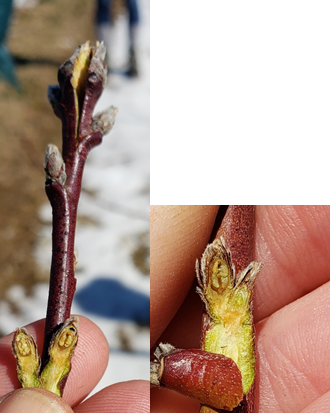
Peach buds with cold injury, Photo: Amanda McWhirt
In an effort to assess cold injury following this event we went out over the last week and assessed buds, canes and stems for symptoms of cold injury in several locations in the state. Common symptoms of cold injury are dark spots in the center of buds and darkening of the vascular tissue in the canes and stems.
- Peaches:
- Minor to severe damage. Some level of injury to buds was observed on most samples, but rates of bud damage varied from 0-100% depending on the location. Some later cultivars did not show damage at locations where temperatures only got to just below 0° F. Other locations where the lows reached -20° F had close to 100% damage to buds that were examined.
- Blackberries:
- Minor to severe damage to buds was observed with rates of bud damage varying from 10-75%.
- Very high rates of injury (>60%) observed on ‘Prime-Ark Freedom’ at most locations. ‘Prime-Ark Freedom’ had broken bud at several locations.
- ‘Prime-Ark Traveler’ showed little damage at one location and ‘Prime-Ark 45’ showed little bud damage at a location where the low temperature reached -3° F. We will continue to monitor both of these.
- ‘Natchez’ had moderate levels of injury (20-40%) observed to buds at all sampling locations.
- Minor to no damage observed in buds for ‘Ponca’ and ‘Ouachita’. I don’t think this means that they survived “without” any damage and we will continue to monitor in the coming weeks.
- We mostly examined primary buds. Secondary buds for the most part were difficult to examine but in most cases when they were visible most appeared to be ok. We will continue to monitor this. Blackberries do have the potential for a crop on secondary buds, however it is still uncertain how much of a secondary crop is still possible given the extreme cold.
- Cane injury externally and internally was observed on some samples. This shows up as withering of the cane on the outside or darkening of the internal portion of the cane just below the surface of the bark
- Minor to severe damage to buds was observed with rates of bud damage varying from 10-75%.
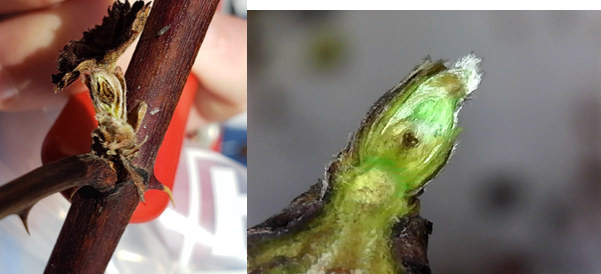
Example: Blackberry buds with cold injury, photo: Amanda McWhirt
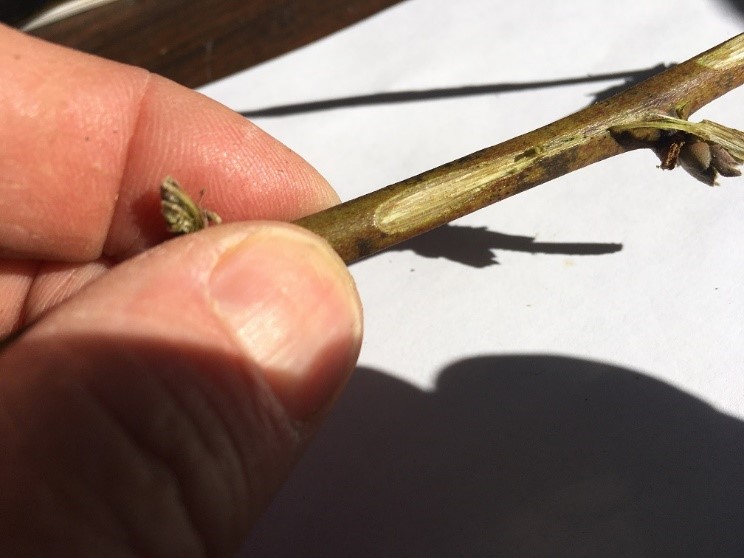
Blackberry cane injury, Photo: Dave Freeze
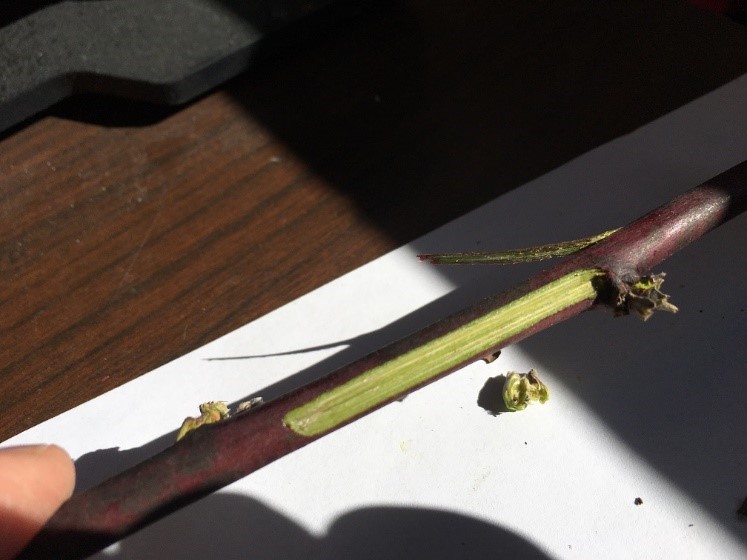
Blackberry cane not showing injury, Photo: Dave Freeze
- Strawberries:
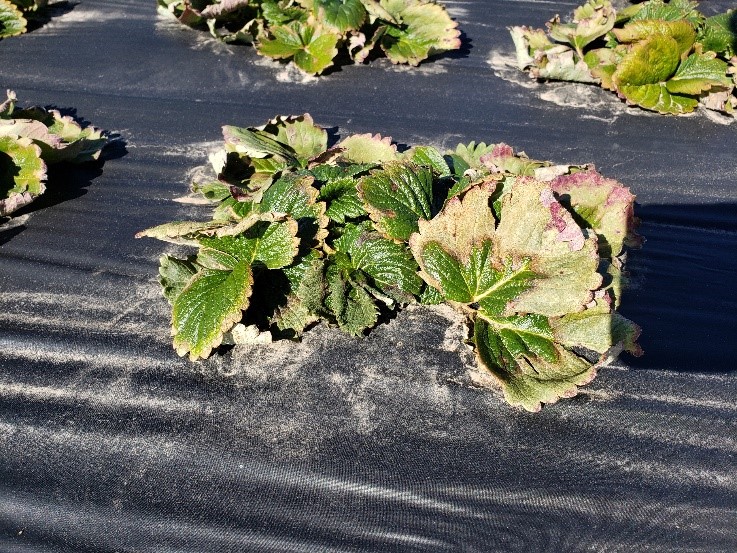
Freeze injury to strawberry leaves, Photo: Amanda McWhirt
- No damage to very minor damage observed to crowns. The snow cover likely saved much of the strawberry crop as it now stands.
- Emerged buds and blooms did show damage and will be lost.
- This early cold event is an example of why there is risk of using row covers in the winter/dormant period to force the crop earlier which can result in more emerged buds during this time of year.
- Mostly there was crown damage on plants that didn’t have a row cover or were on the end of a row and didn’t have good snow cover.
- Some cultivars tended to show more crown damage than others.
- ‘Fronteras’ and ‘Albion’ had higher rates of crown damage but it was still very minor. We have seen in the previous trials that these two cultivars tend to be less cold hardy in our area.
- Branch crowns in some cases had minor damage while the main crown had none.
- Severe cold injury to leaves on strawberries is likely to be present, this should not impact yield as many of these leaves are older and new leaves will be emerging shortly. Old dead leaves should be removed, as they present a potential source of inoculum for botrytis.
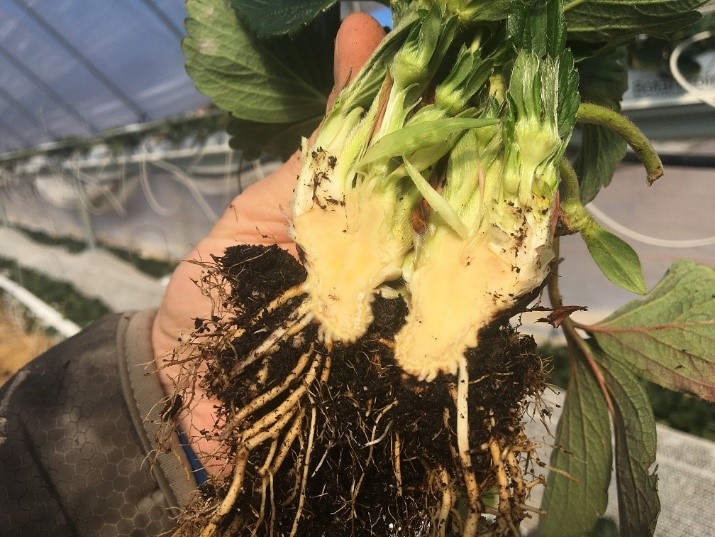
Strawberry crown without injury, Photo: Dave Freeze
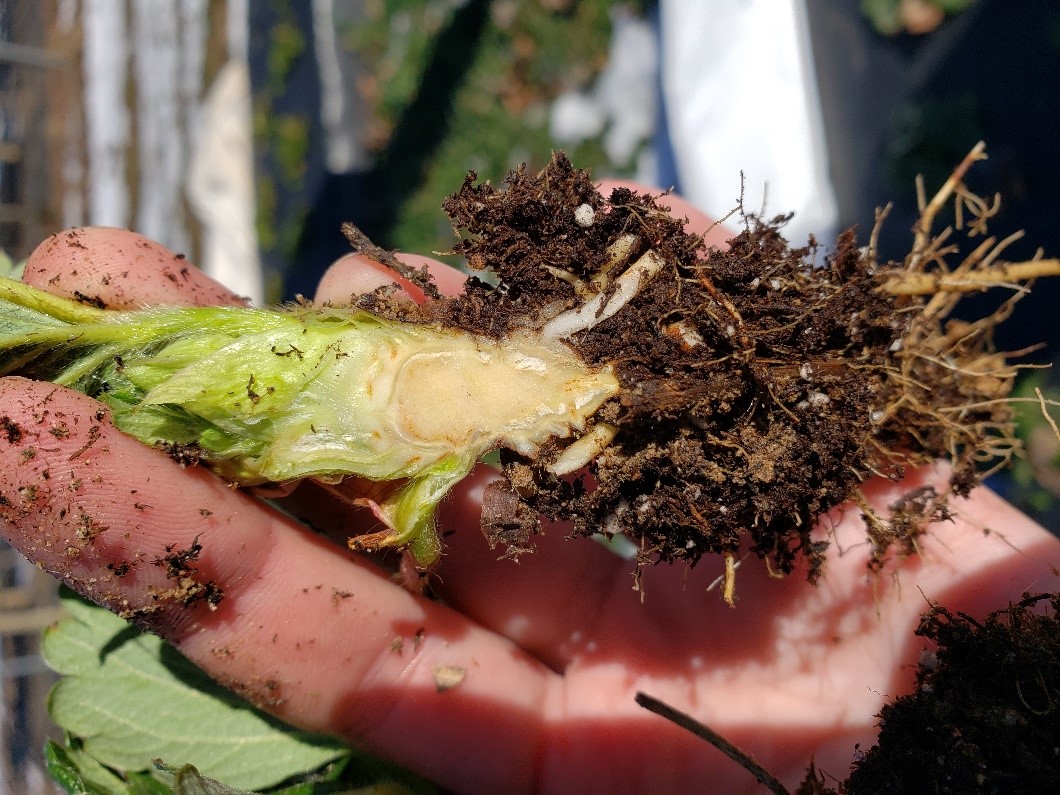
Strawberry crown showing minor cold injury to some parts of the top of the crown (minor darkening/browning) Photo: Amanda McWhirt
- Blueberries:
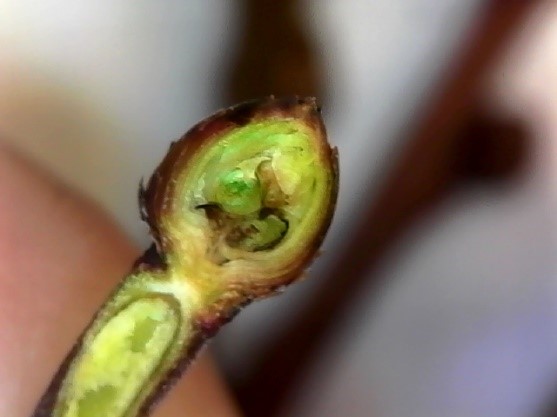
Blueberry bud with injury, photo: Amanda McWhirt
- Northern highbush types
- No damage observed.
- Southern highbush types
- Some severe damage depending on the crop stage and cultivar
- ‘New Hanover’ and ‘Pink Lemonade’ had severe damage (>70%); ‘Legacy’ had very little damage to buds
- Rabbiteye types-
- Minor to severe damage. At northern locations where temperatures got below -10° F there was major damage (>70%) observed to buds; minor damage was observed at locations where lows were just below 0° F
- Northern highbush types
- Grapes (table grapes):
- No damage observed.
- We were only able to look at two table grape samples that both appeared to be fine, we will continue to monitor.
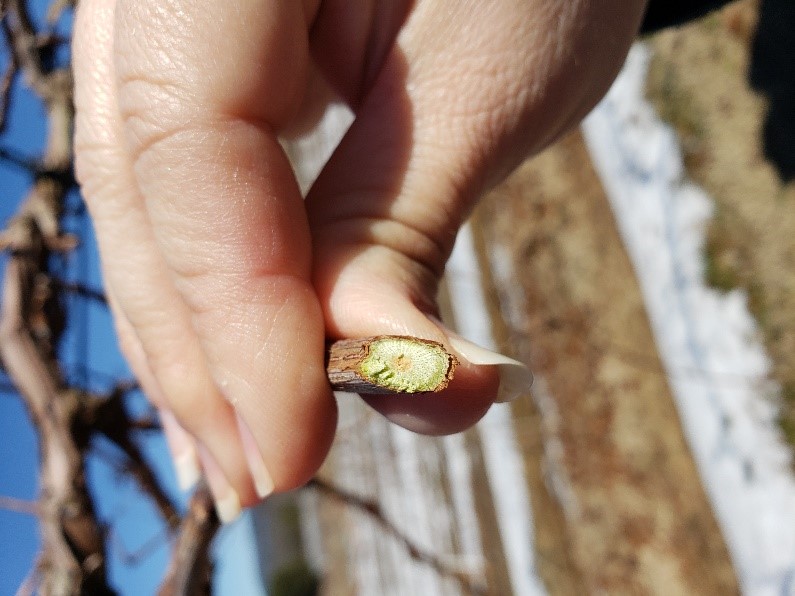
Grape cane that is still green, showing no damage. Photo: Amanda McWhirt
- Muscadines:
- Expecting damage
- It is hard to assess damage on muscadine because the vascular system is more sensitive than the buds. So what you may see now is cracking in the trunk or cordons or browning in the canes.
- If damage is present when the buds breaks later in the spring the buds will break but won’t develop and will wither and die. The plant will re-sprout from the ground and will have to be re-trained.
Take home messages:
- You will want to examine your crops and look for damage at your location.
- Seeing some damage doesn’t necessarily mean no flowers or fruit will form. For some crops it may just mean fewer blooms.
- Not seeing damage on buds now doesn’t mean it isn’t there or isn’t present in the
vascular tissue, it will take some time to know the full extent of the damage
- Buds may have survived but if the vascular tissue is damaged, this means the “plumbing” supplying water and nutrients to the buds won’t work. In this case the buds may break but then die.
- 20% of buds damaged doesn’t necessarily equate to 20% less crop.
- On peaches some of the crop is ‘thinned’ off or removed, so minor damage may not be noticeable
- There is still the potential for damage to the canes and stems in the vascular tissue as previously mentioned.
- We still have to make it through bloom. Flowering is the most cold sensitive stage.
What to watch for in the coming weeks:
The full extent of the cold damage will not be known for several weeks. Possible symptoms of cold injury can include:
- Buds fail to break, (no fruit produced)
- Buds break but then fail to develop further, or don’t flower normally (no fruit produced)
- Buds break and develop but have fewer flowers per bud or flowers per plant (reduced fruit crop)
Follow up: What should I do if my crop has been damaged by frost?
- Wait for now to see the extent of damage. Pruning or clean-up to remove dead canes or stems may be required.
- Plan to fertilize and irrigate normally, “extra” wont help at this point and if the plants have a reduced crop-load they won’t need extra fertility to grow.
- Normal fungicide programs for most crops should be planned for now. Dead plant tissue can be a source of inoculum for some diseases.
- We will follow up with more recommendations as we know more.